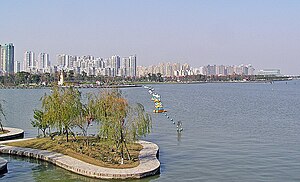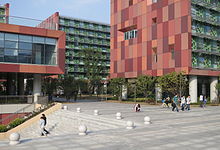Suzhou Industrial Park
China–Singapore Suzhou Industrial Park
苏州工业园区 | |
|---|---|
 | |
| Country | China |
| Province | Jiangsu |
| Prefecture | Suzhou |
| Area | |
| • Total | 288 km2 (111 sq mi) |
| Population | c. 2,000,000 |
| Time zone | UTC+8 (China Standard) |
| Website | http://www.sipac.gov.cn/english/ |
The China–Singapore Suzhou Industrial Park (simplified Chinese: 中国—新加坡苏州工业园区; traditional Chinese: 中國—新加坡蘇州工業園區; pinyin: Zhōngguó—Xīnjiāpō Sūzhōu Gōngyè Yuán Qū), or Suzhou Industrial Park for short, abbreviated as SIP, is a county-level administrative area located in Suzhou, China with significant Singaporean influence.
Background


In the late 1980s, as China's modernisation drive gained momentum, a lot of Chinese delegations visited Singapore, a southeast Asian nation that achieved notable economic success within 30 years of independence. The Chinese visitors were eager to learn modern management methods, while Singapore was also planning Economic Regionalisation, which focused on overseas investment.
In 1992, the idea of developing a modern industrial township with Singapore experience was broached. During his tour of southern China that year, China's late paramount leader Deng Xiaoping said: "Singapore enjoys good social order and is well managed. We should tap on their experience, and learn how to manage better than them."
After rounds of discussions and site surveys, both governments decided to join hands in developing a modern industrial park in the east of Suzhou. The China–Singapore Suzhou Industrial Park (CS-SIP) was thus born on February 26, 1994 when Chinese Vice Premier Li Lanqing and Singapore Senior Minister Lee Kuan Yew signed the Agreement on the Joint Development of Suzhou Industrial Park in Suzhou.[1]
SIP has a total jurisdiction area of 288 km2, of which, the China-Singapore cooperation area covers 80 km2 with a planned residential population of 1.2 million. The China-Singapore Joint Steering Council led by Chinese Vice Premier Wu Yi and Singapore Deputy Prime Minister Wong Kan Seng will hold meeting every year to give directions for the development of SIP.[2]
Jinji Lake (literally Golden Chicken Lake) is a small fresh water lake located in the central part of Suzhou Industrial Park. It occupies an area of 7.18 square kilometres and its average depth is about 2.5 to 3 metres. There are two man-made islands in the lake.[3]
Dushu Lake Higher Education Town

For education in SIP there is Suzhou Dushu Lake Higher Education Town, one of the government's key projects. Located east of Dushu Lake, it has a total area of 25 km2, and expects to have around 400,000 people by 2016, 100,000 of whom will be students. Its goal is to offer good education, advanced technology, and a pleasant living environment. The area is home to many universities (undergraduate as well as graduate schools) including local Chinese universities and universities from other countries. This community focuses on producing educated and creative people.[4] The area offers facilities including libraries, entertainment venues, parks, a sports centre and accommodation. Wenxing Plaza and Hanlin Plaza are popular locations of many small restaurants and shops. Dushu Lake Library is an experimental library of the National Digital Library.
Xi'an Jiaotong-Liverpool University
In May 2006, Suzhou Industrial Park's Higher Education Town became the location for the second Sino-British University to be approved by the Chinese Ministry of Education when, in partnership with Xi’an Jiaotong University, the University of Liverpool opened a joint University known as the Xi’an Jiaotong-Liverpool University (XJTLU). This is an independent University, offering degree courses in Biosciences, Chemistry, Public Health, Architecture, Urban Planning and Design, Electronics, Mathematics, Engineering, Communications, Computer Science, Business and Management, Public Health, and China Studies. When fully operational, this independent university will have a student population of up to fourteen thousand.
Controversy
The SIP ran into trouble when local officials began building Suzhou New District (SND) industrial park to compete with it. As the Suzhou city government had only a minority (35%) stake in the SIP, while they had a major stake in SND, the city government largely ignored SIP and concentrated on promoting the SND instead.
The project was supposed to transfer Singapore's management skills to Chinese bureaucrats and to teach China how to build and run "business-friendly" commercial parks. But it ended up straining the close relations between Singapore and China and bringing home to Singaporeans the often unpredictable, and sometimes underhand, business culture of the Communist mainland.[5]
Singapore's senior minister, Lee Kuan Yew conceded that the project had not turned out as planned and had made him more cautious about investments in China. He pointed to the difficulties that arose in signing agreements with the central government that were then implemented by local officials who "have their own imperatives".[6]
After incurring losses of some US$90 million over 5 years,[7] the Singapore consortium lowered its stake to 35 percent, raising the Chinese consortium's stake to 65 percent from 35 percent and reducing the Singaporean share from a planned 70 km2 to just 8 km2.[8] The Chinese side appointed Wang Jinhua, vice-mayor of Suzhou and the former manager of the New District, as the new chief executive.
In 2001, one year after Singapore lowered its stake, the park made its first profit of $3.8 million.[9]
See also
References
- ^ see Alexius A. Pereira (2003) State Collaboration and Development Strategies: The Case of the China Singapore Suzhou Industrial Park (1992-2002). London: Routledge.
- ^ "Suzhou Industrial Park". RightSite.asia. 1994-02-26. Retrieved 2012-02-07.
- ^ "金鸡湖景区" (in Chinese). Retrieved 2012-06-28.
- ^ "苏州独墅湖高等教育区". Sipedi.com. Archived from the original on 2012-02-07. Retrieved 2012-02-07.
{{cite web}}: Unknown parameter|deadurl=ignored (|url-status=suggested) (help) - ^ https://mobile.nytimes.com/1999/10/01/business/worldbusiness/singapore-industrial-park-flounders-a-deal-sours-in.html
- ^ https://mobile.nytimes.com/1999/10/01/business/worldbusiness/singapore-industrial-park-flounders-a-deal-sours-in.html
- ^ "Losses in Singapore Suzhou project to hit US$90 million", Agence France-Presse, September 15, 1999
- ^ "Suzhou project: wounded pride". Ben Dolven, Far Eastern Economic Review, July 8, 1999.
- ^ "The new frontier". Ben Dolven, Far Eastern Economic Review, December 6, 2001.
